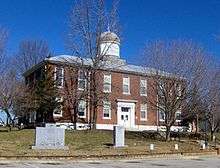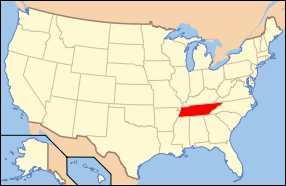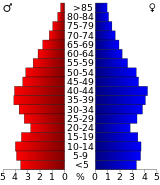Dickson County, Tennessee
| Dickson County, Tennessee | |
|---|---|
 Dickson County Courthouse in Charlotte | |
|
Location in the U.S. state of Tennessee | |
 Tennessee's location in the U.S. | |
| Founded | Oct. 25, 1803 |
| Named for | William Dickson[1] |
| Seat | Charlotte |
| Largest city | Dickson |
| Area | |
| • Total | 491 sq mi (1,272 km2) |
| • Land | 490 sq mi (1,269 km2) |
| • Water | 1.4 sq mi (4 km2), 0.3% |
| Population (est.) | |
| • (2015) | 51,487 |
| • Density | 101/sq mi (39/km²) |
| Congressional district | 5th |
| Time zone | Central: UTC-6/-5 |
| Website |
dicksoncountytn |
Dickson County is a county located in the U.S. state of Tennessee. As of the 2010 census, the population was 49,666.[2] Its county seat is Charlotte.[3]
Dickson County is part of the Nashville-Davidson–Murfreesboro–Franklin, TN Metropolitan Statistical Area.
Dickson County is home to Tennessee's oldest courthouse in continuous use, built in 1835. This is the second courthouse in Charlotte as the first one, a log building, was destroyed in the Tornado of 1833, which destroyed all but one building on the courthouse square.
History
October 25, 1803 the Tennessee General Assembly passed a bill creating Dickson County, the 25th of Tennessee's 95 counties. It was formed from parts of Montgomery and Robertson counties, and was named for William Dickson, a Nashville physician then serving in the United States Congress.[1] Dickson never lived in the county, but his relatives were prominent in its early development. Dickson was a close friend of President Andrew Jackson.
General James Robertson built the first iron works in west Tennessee in Dickson County. Robertson sold his furnace in 1804 to Montgomery Bell (1769–1855), who became one of the state's wealthiest capitalists and industrialists.[1]
Educational institutions
Prior to the 1920s, numerous private high schools and colleges existed in Dickson County. These included the Tracy Academy, Charlotte Female School, Alexander Campbell School, Edgewood Academy and Normal College, the Dickson Academy, Dickson Normal School (where Hattie Carraway, the first woman elected to the U.S. Senate, was educated), Glenwylde Academy, and Ruskin Cave College. Most of these closed before or during the Great Depression.[4] As is typical of most Tennessee counties, all public schools of the county are currently operated by a single county-wide school district.
The Ruskin Colony and The Coming Nation

The Ruskin Colony (or Ruskin Commonwealth Association) was a 250-member, utopian socialist cooperative established in Dickson County in 1894. Initially located near Tennessee City, it relocated to what is now Ruskin. Internal conflict had brought about the dissolution of the colony by 1899.[1]
The Coming Nation, a socialist communalist paper established by Julius Augustus Wayland in Greensburg, Indiana, was relocated to the Ruskin Colony. It was the forerunner of the Appeal to Reason, which later became a weekly political newspaper published in the American Midwest from 1895 until 1922. The Appeal to Reason was known for its politics, giving support to the Farmers' Alliance and People's Party, before becoming a mainstay of the Socialist Party of America following its establishment in 1901. Using a network of highly motivated volunteers known as the "Appeal Army" to increase its subscription sales, the Appeal's paid circulation climbed to over a quarter million by 1906, and half a million by 1910, making it the largest-circulation socialist newspaper in American history.[5][6]
U.S. Route 70
In July 1917, a mass meeting was held in the Alamo Theatre in Dickson to raise $760 (equivalent to $25,000 in 2016) to pay for the surveying of the Bristol to Memphis Highway through Dickson County. The money was raised in less than 15 minutes by donations from those present at the meeting. State highway surveyors began surveying the route on August 14, 1917. The building of this highway put the county along the route from New York to San Francisco known as the “Broadway of America,” now Highway 70.
Governor Frank G. Clement
On November 4, 1952, Frank G. Clement (1920–1969) of Dickson was elected Governor of Tennessee. He served as governor from 1953 to 1959, and again from 1963 to 1967. Known for his energetic speaking ability, he delivered the keynote address at the 1956 Democratic National Convention. The Hotel Halbrook, where Clement was born, still stands in Dickson, and has been listed on the National Register of Historic Places.
Geography
According to the U.S. Census Bureau, the county has a total area of 491 square miles (1,270 km2), of which 490 square miles (1,300 km2) is land and 1.4 square miles (3.6 km2) (0.3%) is water.[7]
Dickson County is bordered on the northeast by the Cumberland River. The Harpeth River passes along the county's eastern border.
Ruskin Cave, site of the former socialist colony, is located 8 miles (13 km) northwest of Dickson.
Adjacent counties
- Montgomery County (north)
- Cheatham County (east)
- Williamson County (southeast)
- Hickman County (south)
- Humphreys County (southwest)
- Houston County (northwest)
State protected areas
- Cheatham Lake Wildlife Management Area (part)
- Hotel Halbrook Railroad and Local History Museum (state historic site)
- Montgomery Bell State Natural Area
- Montgomery Bell State Park
Demographics
| Historical population | |||
|---|---|---|---|
| Census | Pop. | %± | |
| 1810 | 4,516 | — | |
| 1820 | 5,190 | 14.9% | |
| 1830 | 7,265 | 40.0% | |
| 1840 | 7,074 | −2.6% | |
| 1850 | 8,404 | 18.8% | |
| 1860 | 9,982 | 18.8% | |
| 1870 | 9,340 | −6.4% | |
| 1880 | 12,460 | 33.4% | |
| 1890 | 13,645 | 9.5% | |
| 1900 | 18,635 | 36.6% | |
| 1910 | 19,955 | 7.1% | |
| 1920 | 19,342 | −3.1% | |
| 1930 | 18,491 | −4.4% | |
| 1940 | 19,718 | 6.6% | |
| 1950 | 18,805 | −4.6% | |
| 1960 | 18,839 | 0.2% | |
| 1970 | 21,977 | 16.7% | |
| 1980 | 30,037 | 36.7% | |
| 1990 | 35,061 | 16.7% | |
| 2000 | 43,156 | 23.1% | |
| 2010 | 49,666 | 15.1% | |
| Est. 2015 | 51,487 | [8] | 3.7% |
| U.S. Decennial Census[9] 1790-1960[10] 1900-1990[11] 1990-2000[12] 2010-2014[2] | |||

As of the census[14] of 2000, there were 43,156 people, 16,473 households, and 12,173 families residing in the county. The population density was 88 people per square mile (34/km²). There were 17,614 housing units at an average density of 36 per square mile (14/km²). The racial makeup of the county was 93.25% European American, 4.58% Black or African American, 0.40% Native American, 0.27% Asian, 0.01% Pacific Islander, 0.47% from other races, and 1.01% from two or more races. 1.12% of the population were Hispanic or Latino of any race.
There were 16,473 households out of which 35.60% had children under the age of 18 living with them, 58.30% were married couples living together, 11.50% had a female householder with no husband present, and 26.10% were non-families. 22.30% of all households were made up of individuals and 8.90% had someone living alone who was 65 years of age or older. The average household size was 2.59 and the average family size was 3.02.
In the county, the population was spread out with 26.60% under the age of 18, 8.10% from 18 to 24, 30.70% from 25 to 44, 22.90% from 45 to 64, and 11.70% who were 65 years of age or older. The median age was 36 years. For every 100 females there were 96.20 males. For every 100 females age 18 and over, there were 92.90 males.
The median income for a household in the county was $39,056, and the median income for a family was $45,575. Males had a median income of $32,252 versus $23,686 for females. The per capita income for the county was $18,043. About 8.10% of families and 10.20% of the population were below the poverty line, including 12.90% of those under age 18 and 11.80% of those age 65 or over.
By 2005 the county had a population that was 92.0% non-Hispanic white, 4.4% African-American and 1.7% Latino.
Communities
City
Towns
- Burns
- Charlotte (county seat)
- Slayden
- Vanleer
- White Bluff
Unincorporated communities
See also
References
- 1 2 3 4 George E. Jackson, "Dickson County," Tennessee Encyclopedia of History and Culture. Retrieved: 26 June 2013.
- 1 2 "State & County QuickFacts". United States Census Bureau. Retrieved November 29, 2013.
- ↑ "Find a County". National Association of Counties. Retrieved 2011-06-07.
- ↑ Tennessee Encyclopedia entry on Dickson County history
- ↑ Tim Davenport, "The Appeal to Reason: Forerunner of Haldeman-Julius Publications", Big Blue Newsletter No. 3 (2004). Retrieved November 16, 2009.
- ↑ John Simkin, "Appeal to Reason," Spartacus Educational. Retrieved: 26 June 2013.
- ↑ "2010 Census Gazetteer Files". United States Census Bureau. August 22, 2012. Retrieved April 4, 2015.
- ↑ "County Totals Dataset: Population, Population Change and Estimated Components of Population Change: April 1, 2010 to July 1, 2015". Retrieved July 2, 2016.
- ↑ "U.S. Decennial Census". United States Census Bureau. Retrieved April 4, 2015.
- ↑ "Historical Census Browser". University of Virginia Library. Retrieved April 4, 2015.
- ↑ Forstall, Richard L., ed. (March 27, 1995). "Population of Counties by Decennial Census: 1900 to 1990". United States Census Bureau. Retrieved April 4, 2015.
- ↑ "Census 2000 PHC-T-4. Ranking Tables for Counties: 1990 and 2000" (PDF). United States Census Bureau. April 2, 2001. Retrieved April 4, 2015.
- ↑ Based on 2000 census data
- ↑ "American FactFinder". United States Census Bureau. Retrieved 2011-05-14.
External links
| Wikimedia Commons has media related to Dickson County, Tennessee. |
- Official site
- Dickson County Chamber of Commerce
- Dickson County Schools
- Dickson County, TNGenWeb – genealogy resources
- Dickson County at DMOZ
 |
Houston County | Montgomery County |  | |
| |
Cheatham County | |||
| ||||
| | ||||
| Humphreys County | Hickman County | Williamson County |
Coordinates: 36°09′N 87°22′W / 36.15°N 87.36°W